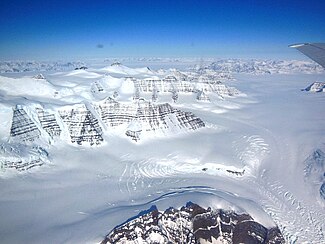
Back Gletser Afrikaans Gletscher ALS Glaciar AN جليدية Arabic হিমবাহ Assamese Glaciar AST Buzlaq Azerbaijani بوزلاق AZB Gletscha BAR Ледавік Byelorussian



A glacier (US: /ˈɡleɪʃər/; UK: /ˈɡlæsiər, ˈɡleɪsiər/) is a persistent body of dense ice that is constantly moving under its own weight. A glacier forms where the accumulation of snow exceeds its ablation over many years, often centuries. It acquires distinguishing features, such as crevasses and seracs, as it slowly flows and deforms under stresses induced by its weight. As it moves, it abrades rock and debris from its substrate to create landforms such as cirques, moraines, or fjords. Although a glacier may flow into a body of water, it forms only on land and is distinct from the much thinner sea ice and lake ice that form on the surface of bodies of water.
On Earth, 99% of glacial ice is contained within vast ice sheets (also known as "continental glaciers") in the polar regions, but glaciers may be found in mountain ranges on every continent other than the Australian mainland, including Oceania's high-latitude oceanic island countries such as New Zealand. Between latitudes 35°N and 35°S, glaciers occur only in the Himalayas, Andes, and a few high mountains in East Africa, Mexico, New Guinea and on Zard-Kuh in Iran.[2] With more than 7,000 known glaciers, Pakistan has more glacial ice than any other country outside the polar regions.[3][1] Glaciers cover about 10% of Earth's land surface. Continental glaciers cover nearly 13 million km2 (5 million sq mi) or about 98% of Antarctica's 13.2 million km2 (5.1 million sq mi), with an average thickness of ice 2,100 m (7,000 ft). Greenland and Patagonia also have huge expanses of continental glaciers.[4] The volume of glaciers, not including the ice sheets of Antarctica and Greenland, has been estimated at 170,000 km3.[5]
Glacial ice is the largest reservoir of fresh water on Earth, holding with ice sheets about 69 percent of the world's freshwater.[6][7] Many glaciers from temperate, alpine and seasonal polar climates store water as ice during the colder seasons and release it later in the form of meltwater as warmer summer temperatures cause the glacier to melt, creating a water source that is especially important for plants, animals and human uses when other sources may be scant. However, within high-altitude and Antarctic environments, the seasonal temperature difference is often not sufficient to release meltwater.
Since glacial mass is affected by long-term climatic changes, e.g., precipitation, mean temperature, and cloud cover, glacial mass changes are considered among the most sensitive indicators of climate change and are a major source of variations in sea level.
A large piece of compressed ice, or a glacier, appears blue, as large quantities of water appear blue, because water molecules absorb other colors more efficiently than blue. The other reason for the blue color of glaciers is the lack of air bubbles. Air bubbles, which give a white color to ice, are squeezed out by pressure increasing the created ice's density.
- ^ a b Craig, Tim (2016-08-12). "Pakistan has more glaciers than almost anywhere on Earth. But they are at risk". The Washington Post. ISSN 0190-8286. Retrieved 2020-09-04.
With 7,253 known glaciers, including 543 in the Chitral Valley, there is more glacial ice in Pakistan than anywhere on Earth outside the polar regions, according to various studies.
- ^ Post, Austin; LaChapelle, Edward R (2000). Glacier ice. Seattle: University of Washington Press. ISBN 978-0-295-97910-6.
- ^ Staff (June 9, 2020). "Millions at risk as melting Pakistan glaciers raise flood fears". Al Jazeera. Retrieved 2020-06-09.
- ^ National Geographic Almanac of Geography, 2005, ISBN 0-7922-3877-X, p. 149.
- ^ "170'000 km cube d'eau dans les glaciers du monde". ArcInfo. Aug 6, 2015. Archived from the original on August 17, 2017.
- ^ "Ice, Snow, and Glaciers and the Water Cycle". www.usgs.gov. Retrieved 2021-05-25.
- ^ Brown, Molly Elizabeth; Ouyang, Hua; Habib, Shahid; Shrestha, Basanta; Shrestha, Mandira; Panday, Prajjwal; Tzortziou, Maria; Policelli, Frederick; Artan, Guleid; Giriraj, Amarnath; Bajracharya, Sagar R.; Racoviteanu,, Adina (November 2010). "HIMALA: Climate Impacts on Glaciers, Snow, and Hydrology in the Himalayan Region". Mountain Research and Development. 30 (4). International Mountain Society: 401–404. doi:10.1659/MRD-JOURNAL-D-10-00071.1. hdl:2060/20110015312. S2CID 129545865.
{{cite journal}}: CS1 maint: multiple names: authors list (link)